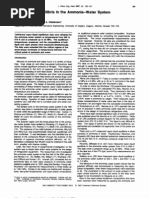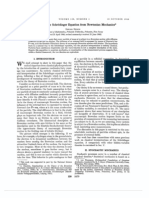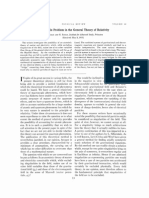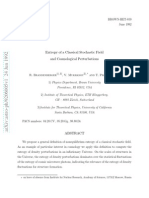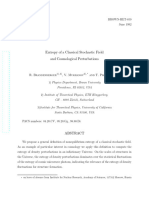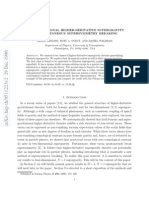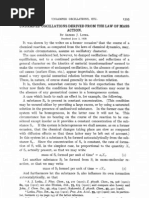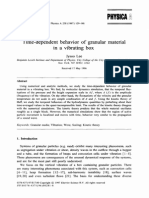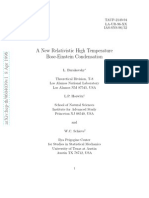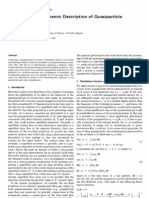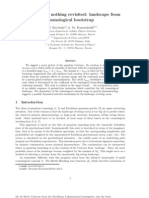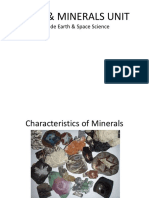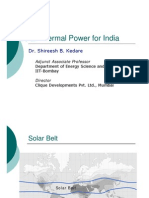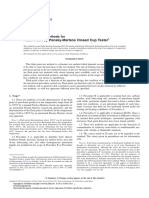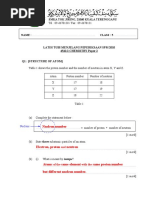Feynman Cycles in The Bose Gas: Physics
Feynman Cycles in The Bose Gas: Physics
Uploaded by
brooklinbookCopyright:
Available Formats
Feynman Cycles in The Bose Gas: Physics
Feynman Cycles in The Bose Gas: Physics
Uploaded by
brooklinbookOriginal Title
Copyright
Available Formats
Share this document
Did you find this document useful?
Is this content inappropriate?
Copyright:
Available Formats
Feynman Cycles in The Bose Gas: Physics
Feynman Cycles in The Bose Gas: Physics
Uploaded by
brooklinbookCopyright:
Available Formats
JOURNAL OF MATHEMATICAL PHYSICS 47, 123303 2006
Feynman cycles in the Bose gas
Daniel Ueltschia
Department of Mathematics, University of Arizona, Tucson, Arizona 85721 Received 25 August 2006; accepted 5 October 2006; published online 29 December 2006
We study the lengths of the cycles formed by trajectories in the Feynman-Kac representation of the Bose gas. We discuss the occurrence of innite cycles and their relation to Bose-Einstein condensation. 2006 American Institute of Physics. DOI: 10.1063/1.2383008
I. INTRODUCTION
Bose and Einstein understood 80 years ago that a curious phase transition occurs in a gas of noninteracting bosons; it is now commonly referred to as the Bose-Einstein condensation. Real particles interact, however, and for many years there were doubts that this transition takes place in natural systems. London suggested in 1938 that superuid helium undergoes a Bose-Einstein condensation, and this idea is largely accepted nowadays. Bogoliubov considered interacting systems; careful approximations allowed him to get back to a noninteracting gas but with a different dispersion relation. See Refs. 16 and 8 for more discussion and partial justications of the Bogoliubov theory. In 1953 Feynman studied the system in the Feynman-Kac representation.5 The partition function can be expanded as a gas of trajectories living in d + 1 dimensions. The extra dimension is commonly referred to as the time, although it is not related to physical time. The situation is illustrated in Fig. 1. A nite system with N particles induces a probability on the group SN of permutations of N elements. Feynman considered the probability for a given particle to belong to a cycle of length n. In the thermodynamic limit, there may be strictly positive probability for innite cycles to be present, and Feynman suggested to use this as an order parameter for BoseEinstein condensation. A few years later, in 1956, Penrose and Onsager introduced the concept of off-diagonal long-range order.9 Formally, it is a correlation between positions x and y given by x , y = cxcy . The system displays off-diagonal long-range order when this correlation is strictly positive, uniformly in the size of the system and in x y . One can write a Feynman-Kac version of this correlation, and it involves a special cycle starting at x and ending at y ; this cycle may wind many times around the imaginary time direction. In the limit where x and y are innitely distant there corresponds a notion of innite open cycle that is reminiscent of Feynmans approach. Feynmans order parameter is simpler; it is often used in numerical simulations or in order to gain heuristic understanding. On the other hand, everybody agrees that the Penrose and Onsager order parameter is the correct one. Surprisingly, the question of their equivalence is usually eluded, and many physicists implicitly assume equivalence to hold. The rst mathematical investigation of this question is due to St, who showed that equivalence holds in the ideal gas. Indeed, he proved that innite cycles occur in the presence of condensation,12 and that no innite cycles occur in the absence of condensation;13 the latter result uses probabilistic methods from the theory of large deviations. These results have been extended to mean-eld systems in Refs. 1 and 3.
a
Electronic mail: ueltschi@email.arizona.edu 47, 123303-1 2006 American Institute of Physics
0022-2488/2006/4712/123303/15/$23.00
Downloaded 05 Jan 2007 to 137.205.234.229. Redistribution subject to AIP license or copyright, see http://jmp.aip.org/jmp/copyright.jsp
123303-2
Daniel Ueltschi
J. Math. Phys. 47, 123303 2006
FIG. 1. The Feynman-Kac representation of the partition function for a gas of bosons. The horizontal plane represents the d spatial dimensions, and the vertical axis is the imaginary time dimension. The picture shows a situation with ve particles and two cycles, of respective lengths 4 and 1.
In this paper we explore the links between Feynman cycles and off-diagonal long-range order. Let x denote the off-diagonal correlation between the origin and x Rd, and n denote the density of particles in cycles of length n. We propose the following formula that relates both concepts:
x =
n1
c n x
n + c x .
1.1
Mathematically, the problem is not well posed. Many choices for the coefcients cn are possiblea trivial choice is cnx = x / for all n, including n = . We will see, however, that there is a natural denition for cnx in terms of Wiener trajectories. In any case, we conjecture that Eq. 1.1 holds with coefcients satisfying 0 cnx 1, for all n , x. In addition, we should have
n
0 cx 1,
lim cnx = cx
for any x, and
x
lim cnx = 0
for any nite n, but not uniformly in n; cx may converge to a strictly positive constant c. If c = 1, we get from the dominated convergence theorem that limx x = in which case the off-diagonal long-range order parameter is equal to the density of cycles of innite lengths. We establish this formula and these properties in the case of the ideal gas, where we show that c n x = e x
2/4n
cx = 1.
1.2
We discuss the validity of formula 1.1 in the interacting gas, proving that these properties hold true in a regime without the Bose-Einstein condensation. The two order parameters should not be always equivalent, however. It is argued in Ref. 15 that they differ when the bosons undergo a regular condensation into a crystalline phase. There is no off-diagonal long-range order, but innite cycles may be present. We work in the Feynman-Kac representation of the Bose gas. This representation is standard, see, e.g., Ref. 4 for a clear and concise review and Ref. 6 for a complete introduction. We assume the reader to possess some familiarity with it and in Sec. II we directly dene the main
Downloaded 05 Jan 2007 to 137.205.234.229. Redistribution subject to AIP license or copyright, see http://jmp.aip.org/jmp/copyright.jsp
123303-3
Feynman cycles in the Bose gas
J. Math. Phys. 47, 123303 2006
expressionspartition functions, density of cycles, and off-diagonal long-range orderin terms of space-time trajectories. But basic notions and properties are reviewed in Appendix A. The situation simplies in the absence of interactions; we consider the ideal gas in Sec. III, where we state and prove the formula that relates the two order parameters. The ideal gas is best discussed in the canonical ensemble. Rigorous proofs of macroscopic occupation of the zero mode have been proposed and they involve the grand-canonical ensemble, with a chemical potential that depends on the volume. Appendix B proposes a simple proof in the canonical ensemble. Interacting systems constitute a formidable challenge; they are discussed in Sec. IV, where partial results are obtained. In this paper, we denote nite volume expressions in plain characters, and innite volume expressions in bold characters. Further, we always consider the canonical and grand-canonical ensembles where the temperature 1 / is xed; we alleviate the notation by omitting the dependence of all quantities.
II. FEYNMAN CYCLES AND OFF-DIAGONAL LONG-RANGE ORDER A. Partition functions
Our Bose gas occupies a d-dimensional domain D, always a cubic box of size L and volume V = Ld. We consider periodic boundary conditions. Let denote the particle density, the inverse temperature, and the chemical potential. The canonical partition function in the Feynman-Kac representation is given by Y N =
N
k=1
1 k!
k
n1,. . .,nk1 n1++nk=N
Dk
dx1 dxk
n1 nk dWx x 1 d W x x k
1 1 k k
j=1
1 U j e nj
e Ui, j .
1i j k
2.1
This expression is illustrated in Fig. 1. In words, we sum over the number k of closed trajectories and over their respective winding numbers n1 , . . . , nk. We integrate over the initial positions denotes x1 , . . . , xk. We integrate over trajectories j : 0 , n j D that start and end at x j; here, Wxx the Wiener measure. See Appendix A for more information and, in particular, Eq. A10 for the normalization condition. Trajectories wind around the time direction according to their winding numbers; because of periodic boundary conditions, they may also wind around space directions. Given a trajectory with winding number n, the function U denotes the interactions between different legs; explicitly, U =
0i jn1
Ui + s j + sds .
2.2
And U , denotes the interactions between closed trajectories and , of respective winding numbers n and n, U , =
0in1 0 jn1
Ui + s j + sds .
2.3
The function Ux represents the pair interaction potential between two particles separated by a distance x. We suppose that Ux is non-negative and spherically symmetric. We can allow the value +; all that is needed is that eU and eU, be measurable functions with respect to the Wiener measureany piecewise continuous function D 0 , can be considered at this point. The grand-canonical partition function is
Downloaded 05 Jan 2007 to 137.205.234.229. Redistribution subject to AIP license or copyright, see http://jmp.aip.org/jmp/copyright.jsp
123303-4
Daniel Ueltschi
J. Math. Phys. 47, 123303 2006
Z =
N0
eNY N
2.4
with the understanding that Y 0 = 1. We also need partition functions where a given trajectory 0 is presentthese will be needed in the expression for cycle densities, see Eqs. 2.8 and 2.9. Namely, we dene Y N ; 0 =
N
k=1
1 k!
k
n1,. . .,nk1 n1++nk=N
Dk
dx1 dxk
n1 nk dWx x 1 d W x x k
1 1 k k
j=1
1 U j e nj
e Ui, j .
0i j k
2.5
The dependence on 0 comes from the last term, where the product includes terms with i = 0. Notice that Y N ; Y N , 2.6
with equality if and only if Ux 0, i.e., in the absence of interactions. Finally, we introduce Z, =
N0
eNY N,
2.7
we set Y 0 , 0 = 1. We also have Z , Z, with equality if and only if Ux 0.
B. Cycle lengths
We now introduce the density of particles in cycles of length n, both in the canonical and grand-canonical ensembles. We denote the particle density by = N / V. When discussing the canonical ensemble, we always suppose that and V are such that N = V is an integer. The number of particles in cycles of length n is given by the random variable k j=1nn j,n. Averaging over all congurations of space-time closed trajectories, we get 1 1 n = Y N k=1 k!
N
n1,. . .,nk1 n1++nk=N
1 n n j,n V j=1
Dk
dx1 dxk
n1 nk dWx x 1 d W x x k
1 1 k k
k j=1
1 U j e nj
e Ui, j =
1i j k
n dW00 e U
Y N n ; . Y N
2.8
The last line follows from the rst line by replacing k j=1nn j,n with nkn1,n, isolating the integral over 1, using denition 2.5, using translation invariance, and Ddx1 = V. Similarly, we have the grand-canonical expression = en
n dW00 e U
Z ; . Z
2.9
One easily checks that
n1
N , V
Downloaded 05 Jan 2007 to 137.205.234.229. Redistribution subject to AIP license or copyright, see http://jmp.aip.org/jmp/copyright.jsp
123303-5
Feynman cycles in the Bose gas
J. Math. Phys. 47, 123303 2006
n1
N V
n1
We consider the thermodynamic limits of n and n. Since 0 n and since n is a discrete index, the Cantor diagonal process yields the existence of a sequence of increasing volumes Vk, with Vk = Nk an integer, such that n converges to some limit that we denote n. Similarly, we also obtain the innite volume limit n. Fatous lemma implies that
n1
2.10
This suggests to dene the density of particles in innite cycles by
n1
n ,
n1
n .
2.11
The main question is whether differs from zero at a given temperature and at a given density or chemical potential. We chose to discuss densities of particles in cycles of given length, but one may consider probabilities as well. Namely, we could introduce the probability for particle 1 to belong to a cycle of length n; it is given by P n =
dx
D
n dWxx e U
Y N n ; . NY N
2.12
Thus n = Pn in the canonical ensemble, and = P. Things are not so simple in the grand-canonical ensemble. The probability Pn is P n =
dx
D
n dWxx
en U Z ; e . n Z
2.13
Here, Z ; is like Z ; given in Eqs. 2.5 and 2.7, but with a factor 1 / k + 1! instead of 1 / k!. Heuristically, we should have V / nk = 1 / and n = Pn, but this does not seem easy to establish. The ratio of partition functions in Eq. 2.13 is more difcult to control than the one in Eq. 2.9. We therefore abandon probabilities and discuss densities.
C. Off-diagonal long-range order
Let us turn to the Penrose and Onsager off-diagonal long-range order. Its Feynman-Kac representation involves an open trajectory that starts at x and ends at y , that possibly winds several times around the time direction. Precisely, we introduce
x =
n=1
n U dW0 x e
Y N n ; , Y N Z ; . Z
x =
en n1
n U dW0 x e
2.14
Thermodynamic limits are denoted x and x, provided they exist. One may actually restrict x and x on rational x and use the Cantor diagonal process to get convergence on a
Downloaded 05 Jan 2007 to 137.205.234.229. Redistribution subject to AIP license or copyright, see http://jmp.aip.org/jmp/copyright.jsp
123303-6
Daniel Ueltschi
J. Math. Phys. 47, 123303 2006
subsequence of increasing volumes. This is not necessary in this paper, as the limits will be shown to exist in the regimes of parameters under consideration. Similarities between Eqs. 2.8 and 2.9 on the one hand and Eqs. 2.14 on the other hand are manifested. We can write
x = c n, x
n=1
n ,
x =
n1
c n, x
1
n ,
2.15
where the coefcients cn,, cn, are given by c n, x =
n dW00 e U
Y N n ; Y N Z ; Z
n U dW0 x e
Y N n ; , Y N Z ; . Z
c n, x =
n dW00 e U
n U dW0 x e
2.16
As above, we denote the thermodynamic limits by cn,x and cn,x, provided they exist. One should be careful when sending the volume to innity in Eqs. 2.15, because a leak to innity may yield a term involving this actually occurs in the ideal gas, as will be shown in the next section.
III. THE IDEAL GAS
The ideal gas of quantum bosons is fascinating. Particles do not interact, yet they manage to display a phase transition. Historically, the Bose-Einstein condensation is the rst theoretical description of a phase transition. The ideal gas has been the object of many studies over the years; let us mention Refs. 17, 7, and 10. A simple proof of macroscopic occupation of the zero Fourier mode is presented in Appendix B. In this section we elucidate the relation between cycle lengths and off-diagonal long-range order, thus clarifying results that were previously obtained by St.12,13 We work in the canonical ensemble and establish formula 1.1 explicitly, for any dimension d 1. Theorem 1: For any 0 , , there exists a sequence of increasing cubes for which the thermodynamic limits of x, cn,x, and n exist for all x Rd and n N. Further, we have
x =
ex /4n n1
2
The rest of this section is devoted to the proof of Theorem 1. The coefcient cn,x, dened in Eq. 2.16, has a simpler expression in the absence of interactions. Indeed, we have U = 0 and Y N ; = Y N. It follows from properties of the Wiener measure in periodic boxes, see Eq. A10, that c n, x =
2
zZd
e L
2/4nx/L z2
e L
2/4nz2
3.1
zZd
Notice that limL cn,x = ex /4n, but the limit is not uniform in n. If the sum over n is restricted to n cL2, with c any nite constant, we can use the dominated convergence theorem and we get
Downloaded 05 Jan 2007 to 137.205.234.229. Redistribution subject to AIP license or copyright, see http://jmp.aip.org/jmp/copyright.jsp
123303-7
Feynman cycles in the Bose gas
cL2
J. Math. Phys. 47, 123303 2006
L n=1
lim
c n, x
ex /4n n1
2
n .
3.2
The limit is taken along the subsequence of increasing volumes for which n is known to converge for any n. We now consider the terms with cL2 n N. We estimate the sums in Eq. 3.1 using integrals; we have
e as b d s 1
e ak b kZ
eas b ds + 1.
3.3
The Gaussian integral is equal to / a. Consequently,
4n L d 4n + L c n, x 4n + L 4n L These bounds hold provided 4n L. Since n / L2 c, we have
3.4
We obtain
4c 1 4c + 1
d N
n=cL2
n=cL2
c n, x
4c + 1 4c 1
d N
n .
3.5
n=cL2
n=cL2
c n, x
4c + 1 4c 1
cL2
n=1
3.6
Using Eq. 3.2 with x = 0 and denition 2.11 of the density of innite cycles, we see that the last term converges to as L . It then follows from Eqs. 3.2 and 3.6 that lim sup x
L
n1
e x
2/4n
n +
4c + 1 4c 1
3.7
This inequality holds for any c, and the fraction is arbitrarily close to 1 by taking c large. A lower bound can be derived in a similar fashion, and we obtain the formula stated in Theorem 1.
IV. THE INTERACTING GAS
The interacting gas is much more difcult to study. We prove in this section the absence of innite cycles when the chemical potential is negative Theorem 2. We then study the coefcients cn,x at low density and high temperature, using cluster expansion techniques. Their thermodynamic limit can be established, and we show that cn,x 0 as x Theorem 3. Theorem 2: Let 0 and 0; then
= 0,
and lim lim sup x = 0.
L
Proof: Since U 0 and Z ; Z, the nite volume density than
n ,
Eq. 2.9, is less
Downloaded 05 Jan 2007 to 137.205.234.229. Redistribution subject to AIP license or copyright, see http://jmp.aip.org/jmp/copyright.jsp
123303-8
Daniel Ueltschi
J. Math. Phys. 47, 123303 2006
n n e
n dW00 =
en 2 2 eL z /4n . 4nd/2 zZd
4.1
The right side is smaller than en for all L large enough. We can therefore apply the dominated convergence theorem and we obtain
= lim
L n1
n1
n .
4.2
It follows that = 0. The statement about the absence of off-diagonal long-range order can be treated similarly. We have the upper bound
x
By dominated convergence,
d/2 n1 4 n
en
ex Lz
2/4n
4.3
zZd
lim sup x
L
x /4n . d/2 e n1 4 n
2
en
4.4
We can again use the dominated convergence theorem for the limit x , and we get the claim. We continue the study of the interacting gas in the regime where cluster expansion converges. We assume that the chemical potential is negative, that the interaction potential Ux is integrable, and that the temperature is high enough. The condition in Theorem 3 is stronger than necessary, but it is very explicit. We will invoke a weaker condition in the proof of the theorem that is based on the Koteck-Preiss criterion for the convergence of cluster expansion. Notice that Ginibres survey6 uses Kirkwood-Salzburg equations; it applies to a broader range of potentials, but things are terribly intricate. Theorem 3: Assume that , , and U satisfy 1 4d/2
Rd
Uxdx nd/2 .
n1
The thermodynamic limits of cn,x and
exist, and we have
lim cn,x = 0
for any n. Proof: We need some notation in order to cast the grand-canonical partition function in a form suitable for the cluster expansion. Let us introduce a measure for trajectories that wind arbitrarily many times around the time direction. Namely, let Xn denote the measure space of continuous trajectories : 0 , n D, and let X = n1Xn be the set of trajectories in D with arbitrary winding numbers. We introduce the measure on X whose integral means the following:
Fd =
n1
en n
dx
D
n dWxx e UF .
4.5
It is clear that is a genuine measure on a reasonable measure space. But we describe the measure with more details for readers who are interested in analytic technicalities. The algebra on Xn is the smallest algebra that contains the sets Xn : t B, for any 0 t n, and any Borel set B D. Trajectories of X1 can be dilated in the time direction so as to yield trajec-
Downloaded 05 Jan 2007 to 137.205.234.229. Redistribution subject to AIP license or copyright, see http://jmp.aip.org/jmp/copyright.jsp
123303-9
Feynman cycles in the Bose gas
J. Math. Phys. 47, 123303 2006
tories with arbitrary winding numbers. One can then consider the product space X1 N with the product algebra the algebra on N being the power set. The measure of a set of the kind A n, with A a measurable subset of X1, is dened as
A n =
Here, we introduced
en n
dx
n dWxx e U .
4.6
A = Xn:t = nt
for some A .
4.7
There is a unique extension to a measure on X1 N. There is a natural correspondence between X and X1 N, and we consider to be a measure on X. With this notation, the grand-canonical partition function 2.4 is given by Z =
k0 k !
Xk
d 1 d k
e U , 1 . 1i j k
i j
4.8
The term k = 0 is equal to 1 by denition. Then Z has exactly the form assumed, e.g., in Ref. 14. The Koteck-Preiss criterion for the convergence of the cluster expansion requires the existence of a function a : X R+ such that the following inequality holds for any X:
1 e U, e ad a .
4.9
Choosing a = n with n the winding number of the trajectory , it was shown in Ref. 14 that Eq. 4.9 is a consequence of the condition in Theorem 3. The main result of the cluster expansion is that the partition function 4.8 is given by the exponential of a convergent series. Namely, Z = exp
k1
Xk
d 1 d k 1, . . . , k .
4.10
The combinatorial function 1 , . . . , k is equal to 1 if k = 1, and is otherwise equal to
1, . . . , k =
1 e Ui, j 1 . k ! G i, j G
4.11
The sum is over connected graphs with k vertices, and the product is over edges of G. A proof for relation 4.10 that directly applies here can be found in Ref. 14. Observe now that the partition function Z ; is given by an expression similar to Eq. 4.8, where each j is replaced by eU, j j. Since U , j is positive, the criterion 4.9 is satised with this new measure. It follows that Z ; has an expansion similar to Eq. 4.10, and we obtain the following expression for the ratio of partition functions: Z ; = exp Z k1 It is not hard to check that 1 e U, j = 1 e U, j e U,i 1 e U, j .
j=1 j=1 i=1 j=1 k k j1 k
Xk
d 1 d k 1 e U, j 1, . . . , k .
j=1
4.12
4.13
Then Eq. 5 in Ref. 14 gives the necessary estimate for the exponent in Eq. 4.12, namely,
Downloaded 05 Jan 2007 to 137.205.234.229. Redistribution subject to AIP license or copyright, see http://jmp.aip.org/jmp/copyright.jsp
123303-10
Daniel Ueltschi
J. Math. Phys. 47, 123303 2006
k1
Xk
d 1 d k
k j=1
1 eU, j 1, . . . , k n .
4.14
This bound is uniform in the size of the domain, which is important. It follows that, as L , the ratio Z ; / Z converges pointwise in and . The thermodynamic limits of cn,x and n then clearly exist. Further, cn,x is bounded by c n, x
n dW00 e U
e2n
n dW0 x .
4.15
It is not hard to show that the bracket is bounded away from zero uniformly in L but not uniformly in and n. From Eq. A10, we have lim lim
x L
n dW0 x = 0.
This implies that cn,x vanishes in the limit of innite x.
V. CONCLUSION
We introduced formula 1.1 that relates the off-diagonal correlation function and the densities of cycles of given length. This formula involves coefcients cn that have a natural denition in terms of integrals of Wiener trajectories. We conjectured several properties for the coefcients these properties can actually be proven in the ideal gas for all temperatures and in the interacting gas for high temperatures. These results seem to indicate that the order parameters of Feynman and Penrose and Onsager agree. However, heuristic considerations based on the present framework15 suggest that, if the gas is in a crystalline phase, the coefcients satisfy cnx eax for some a 0 and for all n including n = . Besides, one expects that 0 if the temperature is sufciently low. The order parameters are not equivalent in this case. An open problem is to establish the equivalence of the order parameters in weakly interacting gases in the presence of the Bose-Einstein condensation. Another question is whether cx converges, as x , to a number that is strictly between 0 and 1. The corresponding phase would display a Bose condensate whose density is less than the density of particles in innite cycles.
ACKNOWLEDGMENTS
It is a pleasure to thank Valentin Zagrebnov and Joe Pul for encouragements and for pointing out an error with thermodynamic potentials in the original version of the manuscript. This research was supported in part by Grant No. DMS-0601075 from the U.S. National Science Foundation.
APPENDIX A: FEYNMAN-KAC REPRESENTATION OF THE BOSE GAS
In this appendix we recall some properties of the Wiener measure, and we review the derivation of the Feynman-Kac representation of the partition functions and of the off-diagonal longrange order parameter. A complete account can be found in the excellent notes of Ginibre;6 Faris wrote a useful survey.4 Let D be the d-dimensional cubic box of size L and volume V = Ld. We work with periodic d boundary conditions, meaning that D is the d-dimensional torus TL . The state space is the Hilbert N space HD,N of square-summable complex functions on D that are symmetric with respect to their arguments. Let S denote the symmetric projector on L2DN, i.e., S x 1, . . . , x N = 1 x 1, . . . , x N , N ! SN A1
where x1 , . . . , xN D and the sum is over all permutations of N elements. The state space for N bosons in D is therefore HD,N = SL2DN, the projection of L2DN onto symmetric functions.
Downloaded 05 Jan 2007 to 137.205.234.229. Redistribution subject to AIP license or copyright, see http://jmp.aip.org/jmp/copyright.jsp
123303-11
Feynman cycles in the Bose gas
J. Math. Phys. 47, 123303 2006
The Hamiltonian of the system is the sum H = T + V of kinetic and interaction energies. The kinetic energy is T = N j=1 j, where j is the Laplacian for the j th particle. Interactions are given by the multiplication operator V = 1i jNUxi x j. Recall that and denote the inverse temperature and the chemical potential, respectively. The canonical and grand-canonical partition functions are Y , V, N = TrHD,NeH , Z, V, = A2 A3
N0
enY , V, N .
Under the assumption that Ux is a stable potential and that it decays faster than xd as x , one can establish the existence of the thermodynamic potentials see Ref. 11 f, = lim
V
1 log Y N , V 1 log Z . V
A4
p, = lim
A5
Further, f and p are related by a Legendre transform, f, = sup
1 p, .
A6
This equation is useful to nd f from p in the case of the ideal gas, where p can be computed explicitly. The Feynman-Kac representation allows to express eH in terms of Wiener trajectories Brownian motion. We briey review the main properties of the Wiener measure. Let X1 be the set of continuous paths : 0 , D. Consider a function F : X1 R of the kind F = f t1, . . . , tn , A7
where f is a bounded measurable function on Dn, and 0 t1 tn ; we extend f on Rd by periodicity. The integral of F with respect to the Wiener measure W xy is given by
FdW xy =
zZd
Rdn
gt1x1 xgt2t1x2 x1 gtny + Lz xn A8
f x 1, . . . , x n d x 1 d x n , where gt is the normalized Gaussian function with mean zero and variance 2t, g t x = 1 2 ex /4t . 4td/2
A9
The sum over z accounts for periodic boundary conditions. A special case of Eq. A8 is when the function F is the constant function F 1; we get
d/2 dW ex y + Lz xy = 4 zZd
2/4
A10
Only the term z = 0 remains in the limit L . It can be proven that such a measure exists and is unique.6 The Wiener measure Wn xy is concentrated on Hlder continuous trajectories with any
Downloaded 05 Jan 2007 to 137.205.234.229. Redistribution subject to AIP license or copyright, see http://jmp.aip.org/jmp/copyright.jsp
123303-12
Daniel Ueltschi
J. Math. Phys. 47, 123303 2006
1 Hlder constant less than 2 that start at x and end at y . Integration with respect to W xy and W00 are related as follows. Dene t = t ty x / ; then
y x FdW xy = e
2/4
FdW00 .
A11
The Feynman-Kac formula states that eH is given by an integral operator.2,4,6 We are actually dealing with bosonic particles, and it is more convenient to consider the operator eH S that also projects onto symmetric functions. We have e HS x 1, . . . , x N = where the kernel K is given by K x 1, . . . , x N ; y 1, . . . , y N = 1 N ! SN
DN
K x 1, . . . , x N ; y 1, . . . , y N y 1, . . . , y N d y 1 d y N ,
A12
exp
i j
dWx y
1 1
1 d W x
N y N
Uis jsds .
N A13
The canonical partition function is then given by Y N =
1 N!
exp
i j
DN
dx1 dxN
dWx x
1 1
1 d W x
Uis jsds .
NxN
N A14
We now group the cycles into closed trajectories, that may wind several times around the time direction. The number of permutations of N elements with k cycles of lengths n1 , . . . , nk with jn j = N is N! k! n j
j
Further, we have
Dn1
dx2 dxn
dWxx 1 d W x y n F =
2 n
dWn xy F .
A15
The trajectory : 0 , n D in the right side is the concatenation of 1 , . . . , n. The partition function A14 can then be rewritten in the form of Eq. 2.1. Let us turn to the Penrose and Onsager off-diagonal long-range order.9 Given a single particle function L2D, we dene the operator N that represents the number of particles in the state . The action of this operator is given by
It is clear that 0 N N and that N , S = 0. Let 0x 1 / V denote the single particle ground state in the absence of interactions. It is also the Fourier function with mode k = 0. The average occupation of the zero mode is given by
A16
Downloaded 05 Jan 2007 to 137.205.234.229. Redistribution subject to AIP license or copyright, see http://jmp.aip.org/jmp/copyright.jsp
123303-13
Feynman cycles in the Bose gas
J. Math. Phys. 47, 123303 2006
0 =
lim
N 0 1 TrHD,N e H . Y N V
A17
We set N = V, and the limit exists at least along a subsequence of increasing volumes. A criterion 0 for the Bose-Einstein condensation is that differs from zero. We can derive a Feynman-Kac expression for this order parameter. From Eqs. A12, A13, and A16, we have TrHD,NNeH = 1 N 1!
dxx
d y y
DN1
dx2 dxN
dWx x
1 1
1 d W x
NNexp Nx
i j
SN
Uis js . A18
1 = y , and x j = x j for 2 j N. Then Here, we set x1 = x, x
0
can be written as A19
= lim
1 V2
D2
x y d x d y ,
where
x y =
1 1 Y , V, N N 1! exp
i j
DN1
dx2 dxN
Uis js .
SN
dWx x
1 1
1 d W x
N Nx
N A20
This expression involves an open cycle from x to y , winding n times around the time direction, with n = 1 , . . . , N. Using the concatenation property A15 and thanks to the combinatorial factor N 1! / N n!, we obtain expression 2.14 for x y . The system displays off-diagonal longrange order if x is strictly positive, uniformly in V , x.
APPENDIX B: A SIMPLE PROOF OF MACROSCOPIC OCCUPATION IN THE IDEAL GAS
In this section, we give a proof of the macroscopic occupation of the zero mode at low temperature. This is usually established in the grand-canonical ensemble, using a chemical potential that varies with the volume and tends to zero in the thermodynamic limit. This approach is rather un-natural and requires large deviation techniques to control the uctuations of the number of particles. The present proof is simpler and stays within the canonical ensemble. The computation of the pressure and of the density in the grand-canonical ensemble can be found in any textbook dealing with quantum statistical mechanics. The chemical potential must be strictly negative. The innite volume pressure is p, = and the density is 1 2d
Rd
log1 ek
dk ,
B1
, =
1 2d
dk e
k2
= 1
Rd
1 ennd/2 . 4d/2 n1
B2
The limit of , as 0 is nite for d 3 and gives the critical density of the ideal Bose gas, c. The graph of p , in three dimensions is plotted in Fig. 2a. Its Legendre transform, Eq. A6, gives f , , see Fig. 2b; it is nonanalytic at c. The value of a is given by
Downloaded 05 Jan 2007 to 137.205.234.229. Redistribution subject to AIP license or copyright, see http://jmp.aip.org/jmp/copyright.jsp
123303-14
Daniel Ueltschi
J. Math. Phys. 47, 123303 2006
FIG. 2. The pressure and the free energy of the ideal gas in three dimensions.
a = lim
1 p, = lim f, .
B3
The very nature of the Bose-Einstein condensation is that the occupation number for k = 0 0 becomes macroscopic. The average occupation of the zero mode , see Eq. A17, can be rewritten as
0 =
lim
1 n 0 n k2 e kk . Y N nk:N V
B4
Here, N = V, and the sum is over all occupation numbers nk 0, with indices k 2 / LZd, such that knk = N. The heart of the Bose-Einstein condensation is the following result. Theorem 4: For d 3, the single particle ground state is macroscopically occupied if c. More precisely,
0 =
max0, c .
0 c.
Proof: It is clear that occupation of the mode k,
0 0.
We now establish that
Let us introduce the average
n k =
1 2 n k e kn kk . Y N nk :N
Thanks to the sum rule N = knk, we have
0 =
lim
V k 0
n k . V
B5
We can view nk as a random variable taking positive integer values; its expectation is therefore given by nk = Probnk i ,
i1
B6
where we dened Probnk i = 1 2 e kn kk . Y N nk :N,i
B7
The sum is restricted to nk such that nk = N and nk i. The change of variable nk nk i leads to
Downloaded 05 Jan 2007 to 137.205.234.229. Redistribution subject to AIP license or copyright, see http://jmp.aip.org/jmp/copyright.jsp
123303-15
Feynman cycles in the Bose gas
J. Math. Phys. 47, 123303 2006
Probnk i = eik
Y N i . Y N
B8
The ratio of partition functions is also equal to the probability Probn0 i, which is smaller than 1. Equations B6 and B8 give a bound for the occupation numbers of all modes k 0, namely, n k 1 e
k2
B9
Notice that nk 1 / k2 L2 / 42 for k 0. This shows that only the zero mode can be macroscopically occupied for d 3. Inserting this bound into Eq. B5, we obtain
0
1 2 d lim 2 V k 0 L
1 e
k2
B10
The limit converges to expression B2 with = 0, which is equal to c. 0 There remains to show that max0 , c. From Eq. B8 with k = 0, and using the equivalence of ensembles, we have for any xed a, lim 1 log Probn0 Va = f, f, a . V B11
The right side of Eq. B11 is strictly negative when a max0 , c. There exists 0 such that for large enough volumes, Probn0 Va eV . B12
Let us assume that c 0; the case c 0 can be treated similarly. Using Eq. B6 with k = 0, together with Eq. B12, we get 1 n 0 1 = Probn0 i + Probn0 i a + eV . V V 1iaV V aViN It follows that
1
B13
is less than any number a c, hence
0 c.
G. Benfatto, M. Cassandro, I. Merola, and E. Presutti, Limit theorems for statistics of combinatorial partition functions with applications to mean eld Bose gas, J. Math. Phys. 46, 033303033341 2005. 2 O. Bratteli, and D. W. Robinson, Operator Algebras and Quantum Statistical Mechanics II Springer, Berlin, 1981. 3 T. C. Dorlas, Ph. A. Martin, and J. V. Pul, Long cycles in a perturbed mean eld model of a boson gas, J. Stat. Phys. 121, 433461 2005. 4 W. G. Faris, The Feynman-Kac Formula, Notes for the Arizona Mathematical Physics Seminar 2004. 5 R. P. Feynman, Atomic theory of the transition in Helium, Phys. Rev. 91, 12911301 1953. 6 J. Ginibre, Some Applications of Functional Integration in Statistical Mechanics, in Statistical Mechanics and Quantum Field Theory, Les Houches, 1970, edited by C. DeWitt and R. Stora Gordon and Breach, New York, 1971, pp. 327427. 7 J. L. Lebowitz, M. Lenci, and H. Spohn, Large deviations for ideal quantum systems, J. Math. Phys. 41, 12241243 2000. 8 E. H. Lieb, R. Seiringer, J. P. Solovej, and J. Yngvason, The Mathematics of the Bose Gas and its Condensation, Oberwohlfach Seminars, Birkhuser 2005; e-print cond-mat/0610117. 9 O. Penrose, and L. Onsager, Bose-Einstein condensation and liquid Helium, Phys. Rev. 104, 576584 1956. 10 J. V. Pul, and V. A. Zagrebnov, The canonical perfect Bose gas in Casimir boxes, J. Math. Phys. 45, 35653583 2004. 11 D. Ruelle, Statistical Mechanics: Rigorous Results Benjamin, New York, 1969. 12 A. St, Percolation transition in the Bose gas, J. Phys. A 26, 46894710 1993. 13 A. St, Percolation transition in the Bose gas II, J. Phys. A 35, 69957002 2002. 14 D. Ueltschi, Cluster expansions and correlation functions, Mosc. Math. J. 4, 511522 2004; e-print math-ph/ 0304003. 15 D. Ueltschi, Phys. Rev. Lett. 97, 170601 2006; e-print cond-mat/0604005. 16 V. A. Zagrebnov, and J.-B. Bru, The Bogoliubov model of weakly imperfect Bose gas, Phys. Rep. 350, 291434 2001. 17 R. M. Ziff, G. E. Uhlenbeck, and M. Kac, The ideal Bose-Einstein gas, revisited, Phys. Rep. 32, 169248 1977.
Downloaded 05 Jan 2007 to 137.205.234.229. Redistribution subject to AIP license or copyright, see http://jmp.aip.org/jmp/copyright.jsp
You might also like
- Physical Approach To Cosmological Homogeneity: G Pup oNo ratings yetPhysical Approach To Cosmological Homogeneity: G Pup o4 pages
- А Ursell. Short surface waves due to an oscillating immersed bodyNo ratings yetА Ursell. Short surface waves due to an oscillating immersed body14 pages
- Pierre Binetruy, Cedric Deffayet and David Langlois - Non-Conventional Cosmology From A Brane-UniverseNo ratings yetPierre Binetruy, Cedric Deffayet and David Langlois - Non-Conventional Cosmology From A Brane-Universe22 pages
- Thermodynamics and Cosmology 1: I. Prigogine, 2'3 J. Geheniau, 3 E. Gunzig, 3 and P. Nardone 3No ratings yetThermodynamics and Cosmology 1: I. Prigogine, 2'3 J. Geheniau, 3 E. Gunzig, 3 and P. Nardone 310 pages
- Some Physical Applications of Fractional Schrödinger EquationNo ratings yetSome Physical Applications of Fractional Schrödinger Equation10 pages
- The Skinner-Rusk Approach For VakonomicNo ratings yetThe Skinner-Rusk Approach For Vakonomic13 pages
- Derivation of The Schrodinger Equation From Newtonian MechanicsNo ratings yetDerivation of The Schrodinger Equation From Newtonian Mechanics7 pages
- The Particle Problem in The General Theory of RelativityNo ratings yetThe Particle Problem in The General Theory of Relativity5 pages
- (Epstein P. S.) On The Air Resistance of Projectil (BookFi)No ratings yet(Epstein P. S.) On The Air Resistance of Projectil (BookFi)16 pages
- Scattering of Long Acoustic Waves in Porous Media: C. Boutin & M. BazailleNo ratings yetScattering of Long Acoustic Waves in Porous Media: C. Boutin & M. Bazaille6 pages
- The Einstein-Myth and The Crisis in Modern PhysicsNo ratings yetThe Einstein-Myth and The Crisis in Modern Physics17 pages
- [Nuclear Physics B - Proceedings Supplements 2003-jul vol. 124 iss. none] Moshe Carmeli - Five-dimensional cosmological theory of unified space, time and velocity (2003) [10.1016_s0920-5632(03)02118-2] - libgen.liNo ratings yet[Nuclear Physics B - Proceedings Supplements 2003-jul vol. 124 iss. none] Moshe Carmeli - Five-dimensional cosmological theory of unified space, time and velocity (2003) [10.1016_s0920-5632(03)02118-2] - libgen.li6 pages
- Where Did The Laws of Physics Come From?: Victor J. StengerNo ratings yetWhere Did The Laws of Physics Come From?: Victor J. Stenger56 pages
- Special Theory of Relativity 1.1 Introduction (II)100% (1)Special Theory of Relativity 1.1 Introduction (II)32 pages
- Entropy of A Classical Stochastic Field and Cosmological PerturbationsNo ratings yetEntropy of A Classical Stochastic Field and Cosmological Perturbations10 pages
- Entropy of A Classical Stochastic Field and Cosmological PerturbationsNo ratings yetEntropy of A Classical Stochastic Field and Cosmological Perturbations10 pages
- The Motion o F Ellipsoidal Particles Immersed A Viscous FluidNo ratings yetThe Motion o F Ellipsoidal Particles Immersed A Viscous Fluid19 pages
- Six Dimension Relativity (Modification of Relativity and Dimension ExpansionNo ratings yetSix Dimension Relativity (Modification of Relativity and Dimension Expansion5 pages
- Department of Physics, University of Pennsylvania Philadelphia, PA 19104-6396, USANo ratings yetDepartment of Physics, University of Pennsylvania Philadelphia, PA 19104-6396, USA26 pages
- 1999 - Complex Systems A Physicists ViewpointNo ratings yet1999 - Complex Systems A Physicists Viewpoint8 pages
- Comment On "Electrophoretic Deposition-Mechanisms, Myths and Materials" by Y. Fukuda, N. Nagarajan, W. Mekky, Y. Bao, H.-S. Kim and P. S. Nicholson (J. Mater. Sci. 39 (2004) 787)No ratings yetComment On "Electrophoretic Deposition-Mechanisms, Myths and Materials" by Y. Fukuda, N. Nagarajan, W. Mekky, Y. Bao, H.-S. Kim and P. S. Nicholson (J. Mater. Sci. 39 (2004) 787)3 pages
- Physica/: Time-Dependent Behavior of Granular Material in A Vibrating BoxNo ratings yetPhysica/: Time-Dependent Behavior of Granular Material in A Vibrating Box20 pages
- A New Relativistic High Temperature Bose-Einstein CondensationNo ratings yetA New Relativistic High Temperature Bose-Einstein Condensation22 pages
- Jeffery - 1922 - The Motion of Ellipsoidal Particles Immersed in A Viscous FluidNo ratings yetJeffery - 1922 - The Motion of Ellipsoidal Particles Immersed in A Viscous Fluid20 pages
- D. I. Pushkarov and R. D. Atanasov - Two-Fluid Hydrodynamic Description of Quasiparticle Gas in CrystalsNo ratings yetD. I. Pushkarov and R. D. Atanasov - Two-Fluid Hydrodynamic Description of Quasiparticle Gas in Crystals4 pages
- A. O. Barvinsky and A. Yu. Kamenshchik - Creation From Nothing Revisited: Landscape From Cosmological BootstrapNo ratings yetA. O. Barvinsky and A. Yu. Kamenshchik - Creation From Nothing Revisited: Landscape From Cosmological Bootstrap12 pages
- Brownian Motion of Stars, Dust, and Invisible Matter: Edmund BertschingerNo ratings yetBrownian Motion of Stars, Dust, and Invisible Matter: Edmund Bertschinger9 pages
- A. H. Taub - Relativistic Fluid MechanicsNo ratings yetA. H. Taub - Relativistic Fluid Mechanics33 pages
- 1948-Vand (J Phys. Colloid Chem) - Viscosity of Solutions and Suspensions I TheoryNo ratings yet1948-Vand (J Phys. Colloid Chem) - Viscosity of Solutions and Suspensions I Theory23 pages
- Klaus Elsasser and Sergey Popel - Plasma Equations in General RelativityNo ratings yetKlaus Elsasser and Sergey Popel - Plasma Equations in General Relativity9 pages
- Uniqueness of Complete Spacelike Hypersurfaces of Constant Mean Curvature in Gener Alized RobertsonWalker Spacetimes Gen RelatiNo ratings yetUniqueness of Complete Spacelike Hypersurfaces of Constant Mean Curvature in Gener Alized RobertsonWalker Spacetimes Gen Relati14 pages
- Vacuum Decay and Internal Symmetries: Physical Review D: Particles and Fields September 1996No ratings yetVacuum Decay and Internal Symmetries: Physical Review D: Particles and Fields September 199612 pages
- Radial Implications of the Unified Field: Classical Solutions for Atoms, Quarks and Other Sub-Atomic ParticlesFrom EverandRadial Implications of the Unified Field: Classical Solutions for Atoms, Quarks and Other Sub-Atomic ParticlesNo ratings yet
- @T - Ih D, WB, VWN, 5C, WB, V, A+5C # #WBWW Aw: D Ao, W +A, 6 #WBW 5W Ww+Wav (Wwaw A +KV Ow5No ratings yet@T - Ih D, WB, VWN, 5C, WB, V, A+5C # #WBWW Aw: D Ao, W +A, 6 #WBW 5W Ww+Wav (Wwaw A +KV Ow570 pages
- Triple Integration With Maple: D D D E F,, Xyz Zyx D D D D H, Xy K, Xy F,, Xyz ZyxNo ratings yetTriple Integration With Maple: D D D E F,, Xyz Zyx D D D D H, Xy K, Xy F,, Xyz Zyx4 pages
- Piecewise Linear Critical Levels and CollapsingNo ratings yetPiecewise Linear Critical Levels and Collapsing10 pages
- Close Isotopies On Piecewise-Linear Manifolds: Neighborhood ofNo ratings yetClose Isotopies On Piecewise-Linear Manifolds: Neighborhood of32 pages
- Penetapan Kadar Zink Pada Sediaan Farmasi Dengan Metode Kompleksometri Dan Spektrofotometri Serapan AtomNo ratings yetPenetapan Kadar Zink Pada Sediaan Farmasi Dengan Metode Kompleksometri Dan Spektrofotometri Serapan Atom10 pages
- Lesson Plan Exo and Endothermic ReactionsNo ratings yetLesson Plan Exo and Endothermic Reactions2 pages
- Physicochemical Properties of Banana Peel Flour As Influenced by Variety and Stage of Ripeness Multivariate Statistical AnalysisNo ratings yetPhysicochemical Properties of Banana Peel Flour As Influenced by Variety and Stage of Ripeness Multivariate Statistical Analysis14 pages
- 1.2 Mechanical Analysis of Soil - CE 304-CE31S8 - Geotechnical Engineering 1No ratings yet1.2 Mechanical Analysis of Soil - CE 304-CE31S8 - Geotechnical Engineering 114 pages
- D93 Flash Point by Pensky-Martens Closed Cup Tester PDFNo ratings yetD93 Flash Point by Pensky-Martens Closed Cup Tester PDF18 pages
- Properties of High Strenght Concrete Subjet To Short Terms LoadsNo ratings yetProperties of High Strenght Concrete Subjet To Short Terms Loads7 pages
- Physical Approach To Cosmological Homogeneity: G Pup oPhysical Approach To Cosmological Homogeneity: G Pup o
- А Ursell. Short surface waves due to an oscillating immersed bodyА Ursell. Short surface waves due to an oscillating immersed body
- Pierre Binetruy, Cedric Deffayet and David Langlois - Non-Conventional Cosmology From A Brane-UniversePierre Binetruy, Cedric Deffayet and David Langlois - Non-Conventional Cosmology From A Brane-Universe
- Thermodynamics and Cosmology 1: I. Prigogine, 2'3 J. Geheniau, 3 E. Gunzig, 3 and P. Nardone 3Thermodynamics and Cosmology 1: I. Prigogine, 2'3 J. Geheniau, 3 E. Gunzig, 3 and P. Nardone 3
- Some Physical Applications of Fractional Schrödinger EquationSome Physical Applications of Fractional Schrödinger Equation
- Derivation of The Schrodinger Equation From Newtonian MechanicsDerivation of The Schrodinger Equation From Newtonian Mechanics
- The Particle Problem in The General Theory of RelativityThe Particle Problem in The General Theory of Relativity
- (Epstein P. S.) On The Air Resistance of Projectil (BookFi)(Epstein P. S.) On The Air Resistance of Projectil (BookFi)
- Scattering of Long Acoustic Waves in Porous Media: C. Boutin & M. BazailleScattering of Long Acoustic Waves in Porous Media: C. Boutin & M. Bazaille
- The Einstein-Myth and The Crisis in Modern PhysicsThe Einstein-Myth and The Crisis in Modern Physics
- [Nuclear Physics B - Proceedings Supplements 2003-jul vol. 124 iss. none] Moshe Carmeli - Five-dimensional cosmological theory of unified space, time and velocity (2003) [10.1016_s0920-5632(03)02118-2] - libgen.li[Nuclear Physics B - Proceedings Supplements 2003-jul vol. 124 iss. none] Moshe Carmeli - Five-dimensional cosmological theory of unified space, time and velocity (2003) [10.1016_s0920-5632(03)02118-2] - libgen.li
- Where Did The Laws of Physics Come From?: Victor J. StengerWhere Did The Laws of Physics Come From?: Victor J. Stenger
- Special Theory of Relativity 1.1 Introduction (II)Special Theory of Relativity 1.1 Introduction (II)
- Entropy of A Classical Stochastic Field and Cosmological PerturbationsEntropy of A Classical Stochastic Field and Cosmological Perturbations
- Entropy of A Classical Stochastic Field and Cosmological PerturbationsEntropy of A Classical Stochastic Field and Cosmological Perturbations
- The Motion o F Ellipsoidal Particles Immersed A Viscous FluidThe Motion o F Ellipsoidal Particles Immersed A Viscous Fluid
- Six Dimension Relativity (Modification of Relativity and Dimension ExpansionSix Dimension Relativity (Modification of Relativity and Dimension Expansion
- Department of Physics, University of Pennsylvania Philadelphia, PA 19104-6396, USADepartment of Physics, University of Pennsylvania Philadelphia, PA 19104-6396, USA
- Comment On "Electrophoretic Deposition-Mechanisms, Myths and Materials" by Y. Fukuda, N. Nagarajan, W. Mekky, Y. Bao, H.-S. Kim and P. S. Nicholson (J. Mater. Sci. 39 (2004) 787)Comment On "Electrophoretic Deposition-Mechanisms, Myths and Materials" by Y. Fukuda, N. Nagarajan, W. Mekky, Y. Bao, H.-S. Kim and P. S. Nicholson (J. Mater. Sci. 39 (2004) 787)
- Physica/: Time-Dependent Behavior of Granular Material in A Vibrating BoxPhysica/: Time-Dependent Behavior of Granular Material in A Vibrating Box
- A New Relativistic High Temperature Bose-Einstein CondensationA New Relativistic High Temperature Bose-Einstein Condensation
- Jeffery - 1922 - The Motion of Ellipsoidal Particles Immersed in A Viscous FluidJeffery - 1922 - The Motion of Ellipsoidal Particles Immersed in A Viscous Fluid
- D. I. Pushkarov and R. D. Atanasov - Two-Fluid Hydrodynamic Description of Quasiparticle Gas in CrystalsD. I. Pushkarov and R. D. Atanasov - Two-Fluid Hydrodynamic Description of Quasiparticle Gas in Crystals
- A. O. Barvinsky and A. Yu. Kamenshchik - Creation From Nothing Revisited: Landscape From Cosmological BootstrapA. O. Barvinsky and A. Yu. Kamenshchik - Creation From Nothing Revisited: Landscape From Cosmological Bootstrap
- Brownian Motion of Stars, Dust, and Invisible Matter: Edmund BertschingerBrownian Motion of Stars, Dust, and Invisible Matter: Edmund Bertschinger
- 1948-Vand (J Phys. Colloid Chem) - Viscosity of Solutions and Suspensions I Theory1948-Vand (J Phys. Colloid Chem) - Viscosity of Solutions and Suspensions I Theory
- Klaus Elsasser and Sergey Popel - Plasma Equations in General RelativityKlaus Elsasser and Sergey Popel - Plasma Equations in General Relativity
- Uniqueness of Complete Spacelike Hypersurfaces of Constant Mean Curvature in Gener Alized RobertsonWalker Spacetimes Gen RelatiUniqueness of Complete Spacelike Hypersurfaces of Constant Mean Curvature in Gener Alized RobertsonWalker Spacetimes Gen Relati
- Vacuum Decay and Internal Symmetries: Physical Review D: Particles and Fields September 1996Vacuum Decay and Internal Symmetries: Physical Review D: Particles and Fields September 1996
- Radial Implications of the Unified Field: Classical Solutions for Atoms, Quarks and Other Sub-Atomic ParticlesFrom EverandRadial Implications of the Unified Field: Classical Solutions for Atoms, Quarks and Other Sub-Atomic Particles
- @T - Ih D, WB, VWN, 5C, WB, V, A+5C # #WBWW Aw: D Ao, W +A, 6 #WBW 5W Ww+Wav (Wwaw A +KV Ow5@T - Ih D, WB, VWN, 5C, WB, V, A+5C # #WBWW Aw: D Ao, W +A, 6 #WBW 5W Ww+Wav (Wwaw A +KV Ow5
- Triple Integration With Maple: D D D E F,, Xyz Zyx D D D D H, Xy K, Xy F,, Xyz ZyxTriple Integration With Maple: D D D E F,, Xyz Zyx D D D D H, Xy K, Xy F,, Xyz Zyx
- Close Isotopies On Piecewise-Linear Manifolds: Neighborhood ofClose Isotopies On Piecewise-Linear Manifolds: Neighborhood of
- Penetapan Kadar Zink Pada Sediaan Farmasi Dengan Metode Kompleksometri Dan Spektrofotometri Serapan AtomPenetapan Kadar Zink Pada Sediaan Farmasi Dengan Metode Kompleksometri Dan Spektrofotometri Serapan Atom
- Physicochemical Properties of Banana Peel Flour As Influenced by Variety and Stage of Ripeness Multivariate Statistical AnalysisPhysicochemical Properties of Banana Peel Flour As Influenced by Variety and Stage of Ripeness Multivariate Statistical Analysis
- 1.2 Mechanical Analysis of Soil - CE 304-CE31S8 - Geotechnical Engineering 11.2 Mechanical Analysis of Soil - CE 304-CE31S8 - Geotechnical Engineering 1
- D93 Flash Point by Pensky-Martens Closed Cup Tester PDFD93 Flash Point by Pensky-Martens Closed Cup Tester PDF
- Properties of High Strenght Concrete Subjet To Short Terms LoadsProperties of High Strenght Concrete Subjet To Short Terms Loads
